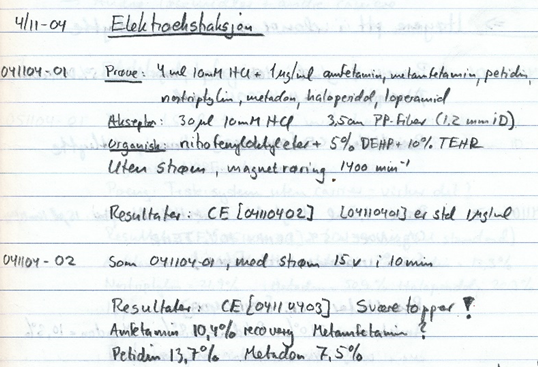Electromembrane extraction (EME) involves selective transfer of charged substances, such as pharmaceuticals, from complex samples (like human blood), across an oil membrane, and into pure water, under the control of an external electrical field. When I did the first experiments together with my colleague Knut Rasmussen during autumn 2004, we did not expect the principle to work, because we have learned in organic chemistry courses that organic acids or bases in their ionized form are not soluble in organic solvents. However, we found our crazy EME idea worth some experiments, and hoped that the rule from organic chemistry was no longer valid when we introduced electricity…
Our initial experiments were not successful, until we came over a bottle of 2-nitrophenyl octyl ether (NPOE) in the back of our laboratory, and tested this solvent as oil membrane. This was done on November 4 (2004), and below you see the corresponding page in our laboratory notebook.

Text was written in Norwegian, but there is a comment about “huge peaks”, and these were found in the chromatogram after analyzing “what was extracted”.
Last week, EME was launched by Extraction Technologies Norway (www.etn-eme.com) at the Analytica 2022 exhibition in Munich (Germany), with more than 30.000 participants (see photo below). From the first successful experiment, it took 6402 days before this new microextraction principle was commercialized, and during this period, we have published 90 scientific articles describing proof-of-principle studies, fundamental understanding, different technical configurations, and a substantial number of applications. Scientists from different “corners of the world” have played with EME in parallel, and in total more than 400 EME scientific articles are available.

EME was born in our laboratory, and up to date EME has been limited to laboratories willing to build their own equipment. Now scientists around the world can buy equipment of industrial standard from a Norwegian company, and do their experiments. I am sure this will increase the awareness and interest for the principle, and we will gradually see more and more EME.
Where this will end, I am not sure. Of course, as analytical chemists, I think about EME as a green alternative for sample preparation. Here is a huge market, when old laboratory managers are replaced with young people thinking sustainability! In addition, we can consider EME as an electrophoretic transfer across liquid-liquid interfaces. We already know the huge impact of electrophoretic techniques, and all the members of this family operate without liquid-liquid interfaces. Therefore, as scientist, I think about EME as a new member of the electrophoretic family. Because the new member is complementary to the others, and is compatible with blood, I think there are no limitations... I am sure EME will be used, but systems and applications may be quite different from those currently reported.
The Analytica launch of EME was extremely important; my feeling for EME is very similar as for my kids when they moved out of house; proud, confident that they will nail it, and humble because to 99 %, external influence will affect their directions and their existence…